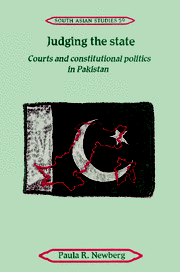Book contents
- Frontmatter
- Contents
- Preface
- Introduction
- 1 Structuring the state
- 2 Constituting the state (1947–1958)
- 3 Confining courts and constitutions (1958–1969)
- 4 Seeking justice (1969–1972)
- 5 Testing courts and constitutionalism (1972–1977)
- 6 Silencing courts, muting justice (1977–1988)
- 7 Reviving judicial powers (1988–1993)
- 8 Judging the state
- Table of cases
- Bibliography
- Index
- Cambridge South Asian Studies
1 - Structuring the state
Published online by Cambridge University Press: 06 January 2010
- Frontmatter
- Contents
- Preface
- Introduction
- 1 Structuring the state
- 2 Constituting the state (1947–1958)
- 3 Confining courts and constitutions (1958–1969)
- 4 Seeking justice (1969–1972)
- 5 Testing courts and constitutionalism (1972–1977)
- 6 Silencing courts, muting justice (1977–1988)
- 7 Reviving judicial powers (1988–1993)
- 8 Judging the state
- Table of cases
- Bibliography
- Index
- Cambridge South Asian Studies
Summary
The constables took Ustad Mangu to the police station. On the way and at the police station, he kept yelling, “The new constitution … the new constitution.” But no one understood what he was referring to. “What are you shouting about … what new laws and rights are you shouting about … the laws are the same old ones …” And Ustad Mangu was locked up in a cell.
Sadaat Hasan Manto, “New Constitution.”A Constitution is not the cause but a consequence of personal and political freedom.
Justice Muhammad Munir.In the forty-five years since its independence, Pakistan has struggled with constitutions, governments and the structure of the state. It has swung between the poles of dictatorship and democracy, and between civilian and military rule. Although it was established with a parliamentary system of government, the military has seized power four times since 1947, ruling directly and indirectly for more than half the life of the country. Intervening periods of elected, civilian government have responded to popular fears of renewed military rule by accommodating the army to prevent its reemergence in politics. Each permutation of power has therefore embodied deep popular concerns and ambivalences about government, its patrons and its beneficiaries.
Many of the same problems of ideology, sovereignty and voice that were present at independence still trouble Pakistan and Pakistanis today. The country has fought wars over its boundaries and domestic battles over conflicting ideas of citizenship, equality and representation.
- Type
- Chapter
- Information
- Judging the StateCourts and Constitutional Politics in Pakistan, pp. 9 - 34Publisher: Cambridge University PressPrint publication year: 1995

